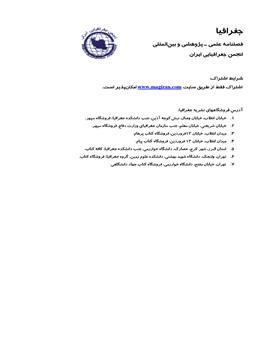EXAMINING THE IMPACT OF CLOSED-CIRCUITED TELEVIOSIONS(CCTV) IN REDUCING URBAN CRIMES
Subject Areas :Mahmood Vasegh 1 , Hossein Hataminejad 2 , shekoofeh jafari fesharaki 3
1 - University of Tehran
2 - University of Tehran
3 -
Keywords: Monitoring and control, intelligent monitoring systems, State holes, urban crimes,
Abstract :
One of the main functions of governments, in better managed of their authority, is monitoring social affairs and citizenship behaviors within the law. Management and organization of social life, in the present era, because of the complexity processes of political, security and… in geographical environment, including major cities are extremely onerous and requires effective and efficient design and development methods and tools in this field. There is a question in this regard that how cans us increase the monitoring and control of the government in these areas. In response to the above question, this paper tries to come to investigate the effects of the application of intelligent monitoring and control systems and instruments (closed-circuited televisions) in reducing delinquency and urban crimes, how to increase government efficiency in controlling urban processes, should be investigated. This paper developed in descriptive-analytic methods and based on the field data, so The analysis and conclusions, in addition to the electronic library resources and results of a questionnaire is used. It should be noted that the validity of the questionnaire using factor analysis and reliability of the questionnaire was tested through Cronbach's alpha multiplied. Finally, the data obtained from the questionnaires were analyzed by examining the population mean (T-test). The results of this study show that the use of intelligent monitoring systems have significant role in reducing crimes in urban environments and social insecurities.
1. پاکزاد، جهانشاه (1381)، میزگرد نقش فضاهای شهری در تامین امنیت اجتماعی، شهرداریها، سال چهارم، شماره 41؛
2. پیشگاهیفرد، زهرا (1385)، چالشهای جامعه ایران از منظر جغرافیای سیاسی، پژوهشهای جغرافیایی، شماره 56. صص13-1؛
3. حاتمینژاد، حسین؛ منصوری، بابر؛ فعلی، محمد؛ تبیین نقش فضاهای شهری در پیشگیری از وقوع جرم و ایجاد امنیت، دوره بیست و دوم، شماره 87. صص76-68؛
4. حافظنیا، محمدرضا (1390)، اصول و مفاهیم ژئوپلیتیک، مشهد: انتشارات پاپلی، چاپ سوم؛
5. ربانی، رسول (1385)، جامعهشناسی شهری، تهران: انتشارات سمت و دانشگاههای اصفهان، چاپ سوم؛
6. رضایی¬مقدم، علی؛ آرزو، حسن؛ یوسفپور، وحید؛ عبادی، مسعود (1391)، بررسی جایگاه طراحی در ایجاد حس امنیت در مجتمعهای مسکونی، چهارمین کنفرانس برنامهریزی و مدیریت شهری، مشهد مقدس، اردیبهشت1391. صص18-1؛
7. سایق، یزید (1377)، امنیت در کشورهای در حال توسعه، ترجمه: علیرضا طیب و مصطفی ایمانزاده، تهران: انتشارات علمی و فرهنگی؛
8. شکویی، حسین (1391)، اندیشههای نو در فلسفه جغرافیا، تهران: مؤسسه جغرافیایی و کارتوگرافی گیتاشناسی، جلد اول، چاپ چهاردهم؛
9. شورچه، محمود (1393)، فوکو، فضا و برنامهریزی، تهران: مدیران امروز، چاپ اول؛
10. قالیباف، محمدباقر و مهدی میرزاده کوهشاهی، ریشهها و پیامدهای حفرههای دولت در محدودهی شمال و خاور هرمزگان و جنوب کرمان، سیاسی- اقتصادی، شماره 264-263. صص107-94؛
11. لطفی، صدیقه؛ بردی¬آنا مرادنژاد، رحیم؛ ساسانیپور، محمد (1393)، بررسی احساس امنیت در فضاهای عمومی(مطالعه موردی: کلانشهر شیراز)، پژوهش و برنامهریزی شهری، سال پنجم، شماره 19. صص56-35؛
12. محمودی جانکی، فیروز و مجید قورچیبیگی (1388)، نقش طراحی محیطی در پیشگیری از جرم، مجله دانشکده حقوق و علوم سیاسی، شماره 2. صص368-345؛
13. مدنیپور، علی(1379)، طراحی فضای شهری، ترجمه: فرهاد مرتضایی، تهران: انتشارات شرکت پردازش و برنامهریزی شهری. صص75-70؛
14. معاونت اجتماعی اداره کل ناجا (1385)، مجموعه مقالات همایش امنیت اجتماعی، جلد اول؛
15. مؤیدی، محمد؛ علینژاد، منوچهر؛ نوایی، حسین (1392)، بررسی نقش مؤلفههای منظر شهری در ارتقای سطح احساس امنیت در فضاهای عمومی شهری(نمونه مورد مطالعه: محله اوین تهران)، فصلنامه مطالعات امنیت اجتماعی، شماره 35. صص191- 159؛
16. نصیری، معصومه و هادی اعظمی (1385)، نابرابریهای شهری تهدیدی برای امنیت اجتماعی تهران رویکردی در جغرافیای سیاسی، ژئوپلیتیک، شماره 13. صص61-42؛
17. Ball, K. Hggerty, K. D. Lyon, D. eds(2012), The Routledge Hand book of Surveillance Studies, London and New-York: Routledge;
18. Bell, W(1998), Women and Community Safety, Bell Planning Associates South Australia, No 32,PP. 1-26;
19. Bennet, T(1986), Situational Crime Prevention From The Offender Perspective, in Heal & Laycoke;
20. Caplan,J. M, Kennedy, L.W, Petrossian, G(2009), Police-monitored CCTV cameras in Newark, NJ: Placement choice and their impact on street crime incident, see www.rutgerscps.org;
21. Clarke, R. V(ED)(1997), Situational Crime Prevention: Successful Case Studies. 2rd ed, Harrow and Heston, New-York;
22. Dickinson, T (2012), The Impact of CCTV on Crime A Review of the Evidence, University of Missouri- Saint Louis. PP. 1-11;
23. Flight, S. Heerwaarden, Y. Soomeren, P. Does CCTV displace Crime? An evaluation of the evidence and a Case Study from Amsterdam, Gepubliceerd in “CCTV” Martin Gill (ed). PP. 1-13;
24. Germain, S. Dumoulin, L. Cecile Douillet, A (2013), A Prosperous ‘Business’: the Success of CCTV through the eyes of international literature, Surveillance & Society, PP. 134-147.
25. Johnston, R. Gregory, D. Smith, D. M(1994), The Dictionary of human geography, 3rd ed. Oxford: black well;
26. Laycock, G. Austin, C(1992), Crime prevention in parking facilities, Security Journal, Vol. 3 No.3;
27. Peterson, P. James, K(1985), Sebenius the Primacy of the Domestic Agenda in Alison and Treverton, Rethinking America Security;
28. Poyner. B(1991), Situational Crime prevention in two parking facilities, Security Journal, Vol.2 No.1;
29. Tiesdell, S(1998), Fear and Gender in Public Space, City center management and safer city centers: approaches in coventry and Nottingham, university Nottingham, institute of urban planning, school of built environment, Pergamon, UK;
30. Welsh, B. C. Farrington, D. P (2009), Effectiveness of CCTV in Reducing Crime Campbell Systematic Review. In Security Journal. PP.1-41.


